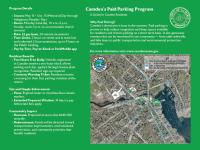The Science is clear: Vote yes on Camden Article 7 for a healthier river
We don’t often get an opportunity in our lifetimes to make truly restorative change that can benefit future generations. So, when one presents itself, we should embrace it.
That’s why so many organizations dedicated to a healthier environment and healthier future for Mainers are supporting the YES on Question 7 campaign in Camden to remove the lowest dam on the Megunticook River. This is a once-in-a-generation opportunity to allow access for fish while maintaining a free-flowing natural waterfall and delivering economic benefits for town residents.
Many of these organizations have scientific experts, who have spent their lives studying the natural world and carefully consider decisions for the positive and negative impacts they might have. Others on this list are community or municipal organizations representing collective interests, putting their credibility behind river restoration as the right thing for their members:
- Camden Conservation Commission
- Camden-Rockport Historical Society
- Camden Public Library
- Downeast Salmon Federation
- FB Environmental
- Georges River Trout Unlimited
- Interfluve
- Knox-Lincoln Soil Water Conservation District
- Maine Department of Marine Resources
- Megunticook River Citizens Advisory Committee
- Megunticook RiverKeepers
- Natural Resources Council of Maine
- The Nature Conservancy
- Penobscot Nation Department of Natural Resources
- Penobscot Bay Waterkeeper
- Senders Engineering
One thing should be made clear. A free-flowing river and the waterfall can co-exist. The volume of water controlled by upstream dams combined with the vertical drop under the Camden Main Street/Route 1 bridge means that the falls will persist when the dam is removed.
The Natural Resources Council of Maine is in full support of this exciting river restoration opportunity based on the experience of being actively involved in the largest river restoration projects in state history on the Kennebec and Penobscot rivers.
We agree with the opinions of other fish passage experts that the watershed can support runs of anadromous fish such as alewives if obstructions are removed and fish passage measures are taken. NRCM’s Woods, Waters, and Wildlife Director and Staff Scientist Luke Frankel also notes other benefits that will accompany dam removal, including improvements in water quality and the passage of sediment and organic matter downstream.
Our conclusion was also derived from the lengthy and inclusive work of the Town of Camden to include input from town voices and experts to come up with a proposal that will reduce flood risks, save money by eliminating dam maintenance, improve recreational and commercial fish harvests, all while creating a more resilient waterfront for future generations, and restoring a stretch of the river to a precedent that respects the Wabanaki fishers and the fish they have lived with for more than 10,000 years.
Restoring the Megunticook by removing the dam will also help improve the long-term health of the Penobscot Bay and Gulf of Maine, as well as the wildlife and fishing businesses that depend on them.
For the health of the river, the health of fish, and the health of the Gulf of Maine we encourage you to join us and so many others in supporting YES on Question 7 in Camden.
Nate Hathaway is the Penobscot Bay – Frenchman Bay Regional Outreach Coordinator for the Natural Resources Council of Maine





















